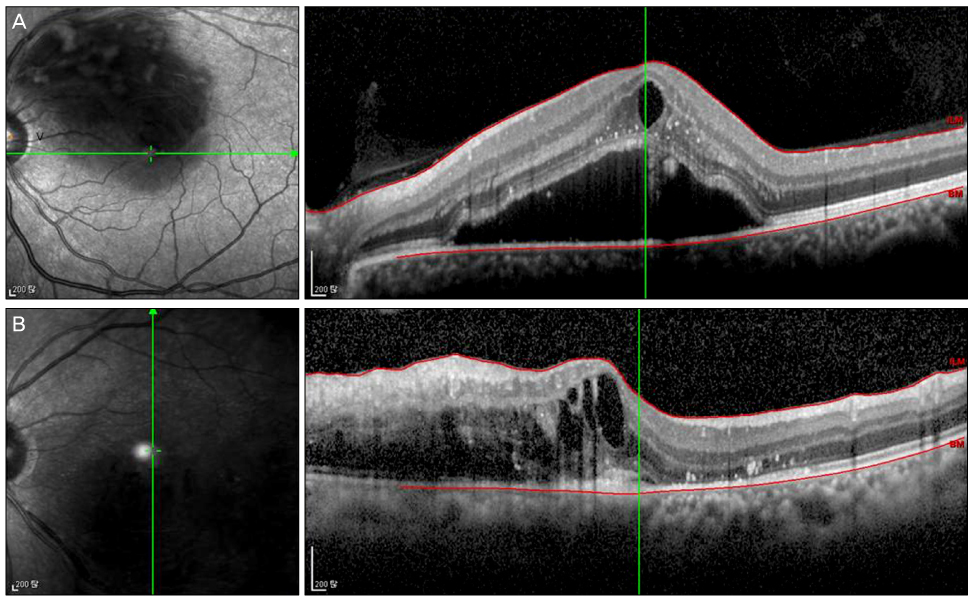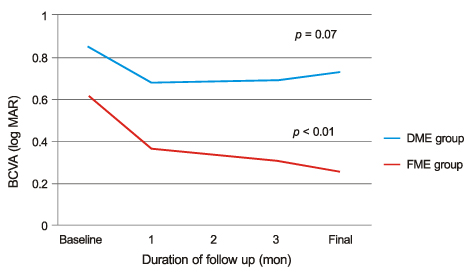J Korean Ophthalmol Soc.
2012 Sep;53(9):1276-1284. 10.3341/jkos.2012.53.9.1276.
Short-Term Visual Outcomes According to Patterns of Macular Edema in Retinal Vein Occlusion Patients
- Affiliations
-
- 1Department of Ophthalmology, Soonchunhyang University College of Medicine, Cheonan, Korea. mdroh@daum.net
- KMID: 2216080
- DOI: http://doi.org/10.3341/jkos.2012.53.9.1276
Abstract
- PURPOSE
To study the short-term visual outcomes affected by the patterns of macular edema in retinal vein occlusion patients.
METHODS
In a retrospective study, 33 eyes of 33 consecutive patients with macular edema from retinal vein occlusion received an intravitreal injection of bevacizumab. Macular edema was classified according to OCT patterns and the effect on visual outcome evaluated: Diffuse macular edema (DME) vs. focal macular edema (FME), and macular edema with serous retinal detachment (SRD) vs. macular edema without serous retinal detachment (non-SRD).
RESULTS
Nine patients had CRVO, 24 patients had BRVO and the follow-up period was 3.6 months. In the FME group, the mean baseline BCVA was 0.61 +/- 0.34 and the final BCVA was 0.26 +/- 0.29, a difference that was statistically significant (p < 0.01). In the DME group, the mean baseline BCVA was 0.85 +/- 0.44 and the final BCVA was 0.73 +/- 0.37, a difference that was not statistically significant (p = 0.07). In the non-SRD group, the mean baseline BCVA was 0.76 +/- 0.43 and the final BCVA was 0.38 +/- 0.36, a difference that was statistically significant (p < 0.01). In the SRD group, the mean baseline BCVA was 0.73 +/- 0.40 and the final BCVA was 0.64 +/- 0.42, a difference that was not statistically significant (p = 0.07).
CONCLUSIONS
Visual outcome was significantly better in the FME and non-SRD groups. The patterns of macular edema measured according to OCT were a prognostic factor for visual outcome.
MeSH Terms
Figure
Cited by 1 articles
-
Short-Term Outcome of Intravitreal Dexamethasone Implant for Macular Edema Secondary to Branch Retinal Vein Occlusion
Sun Ah Kang, Jong Woo Kim, Chul Gu Kim, Tae Gon Lee, Young Ju Lew, Jae Hui Kim
J Korean Ophthalmol Soc. 2015;56(1):39-46. doi: 10.3341/jkos.2015.56.1.39.
Reference
-
1. The Branch Vein Occlusion Study Group. Argon laser photocoagulation for macular edema in branch vein occlusion. Am J Ophthalmol. 1984. 98:271–282.2. Hee MR, Puliafito CA, Wong C, et al. Quantitative assessment of macular edema with optical coherence tomography. Arch Ophthalmol. 1995. 113:1019–1029.3. Konno S, Akiba J, Yoshida A. Retinal thickness measurements with optical coherence tomography and the scanning retinal thickness analyzer. Retina. 2001. 21:57–61.4. Ghil HK, Cho SW, Kim SH. The efficacy of intravitreal triamcinolone acetonide for macular edema in branched retinal vein occlusion. J Korean Ophthalmol Soc. 2004. 45:2029–2035.5. Lee H, Shah GK. Intravitreal triamcinolone as primary treatment of cystoid macular edema secondary to branch retinal vein occlusion. Retina. 2005. 25:551–555.6. Noma H, Funatsu H, Yamasaki M, et al. Pathogenesis of macular edema with branch retinal vein occlusion and intraocular levels of vascular endothelial growth factor and interleukin-6. Am J Ophthalmol. 2005. 140:256–261.7. Priglinger SG, Wolf AH, Kreutzer TC, et al. Intravitreal bevacizumab injections for treatment of central retinal vein occlusion: six-month results of a prospective trial. Retina. 2007. 27:1004–1012.8. Jaissle GB, Ziemssen F, Petermeier K, et al. [Bevacizumab for treatment of macular edema secondary to retinal vein occlusion]. Ophthalmologe. 2006. 103:471–475.9. Iturralde D, Spaide RF, Meyerle CB, et al. Intravitreal bevacizumab (Avastin) treatment of macular edema in central retinal vein occlusion: a short-term study. Retina. 2006. 26:279–284.10. Yang HN, Kim YJ, Kim JC, Shyn KH. Clinical evaluation for branch retinal vein occlusion. J Korean Ophthalmol Soc. 1992. 33:599–604.11. Green WR, Chan CC, Hutchins GM, Terry JM. Central retinal vein occlusion: a prospective histopathologic study of 29 eyes in 28 cases. Trans Am Ophthalmol Soc. 1981. 79:371–422.12. The Central Vein Occlusion Study Group. Natural history and clinical management of central retinal vein occlusion. Arch Ophthalmol. 1997. 115:486–491.13. Rehak J, Rehak M. Branch retinal vein occlusion: pathogenesis, visual prognosis, and treatment modalities. Curr Eye Res. 2008. 33:111–131.14. Aiello LP, Avery RL, Arrigg PG, et al. Vascular endothelial growth factor in ocular fluid of patients with diabetic retinopathy and other retinal disorders. N Engl J Med. 1994. 331:1480–1487.15. Funatsu H, Yamashita H, Nakamura S, et al. Vitreous levels of pigment epithelium-derived factor and vascular endothelial growth factor are related to diabetic macular edema. Ophthalmology. 2006. 113:294–301.16. Rosenfeld PJ, Fung AE, Puliafito CA. Optical coherence tomography findings after an intravitreal injection of bevacizumab (avastin) for macular edema from central retinal vein occlusion. Ophthalmic Surg Lasers Imaging. 2005. 36:336–339.17. Gündüz K, Bakri SJ. Intravitreal bevacizumab for macular oedema secondary to branch retinal vein occlusion. Eye (Lond). 2008. 22:1168–1171.18. Jaissle GB, Leitritz M, Gelisken F, et al. One-year results after intravitreal bevacizumab therapy for macular edema secondary to branch retinal vein occlusion. Graefes Arch Clin Exp Ophthalmol. 2009. 247:27–33.19. Rabena MD, Pieramici DJ, Castellarin AA, et al. Intravitreal bevacizumab (Avastin) in the treatment of macular edema secondary to branch retinal vein occlusion. Retina. 2007. 27:419–425.20. Ach T, Hoeh AE, Schaal KB, et al. Predictive factors for changes in macular edema in intravitreal bevacizumab therapy of retinal vein occlusion. Graefes Arch Clin Exp Ophthalmol. 2010. 248:155–159.21. Kang SJ, Chin HS, Moon YS. Visual prognosis of macular edema associated with macular ischemia in branch retinal vein occlusion. J Korean Ophthalmol Soc. 2002. 43:1621–1628.22. Wolf-Schnurrbusch UE, Ghanem R, Rothenbuehler SP, et al. Predictors of short-term visual outcome after anti-VEGF therapy of macular edema due to central retinal vein occlusion. Invest Ophthalmol Vis Sci. 2011. 52:3334–3337.23. Ota M, Tsujikawa A, Murakami T, et al. Foveal photoreceptor layer in eyes with persistent cystoid macular edema associated with branch retinal vein occlusion. Am J Ophthalmol. 2008. 145:273–280.24. Hoeh AE, Ruppenstein M, Ach T, Dithmar S. OCT patterns of macular edema and response to bevacizumab therapy in retinal vein occlusion. Graefes Arch Clin Exp Ophthalmol. 2010. 248:1567–1572.25. Schatz H, Yannuzzi L, Stransky TJ. Retinal detachment secondary to branch vein occlusion: Part II. Ann Ophthalmol. 1976. 8:1461–1471.26. Lee SW, Kim HK, Kim SY. Patterns of macular edema in patients with branch retinal vein occlusion on optical coherence tomography. J Korean Ophthalmol Soc. 2005. 46:969–975.27. Otani T, Kishi S, Maruyama Y, et al. Patterns of diabetic macular edema with optical coherence tomography. Am J Ophthalmol. 1999. 127:688–693.28. Kang SW, Park CY, Ham DI. The correlation between fluorescein angiographic and optical coherence tomographic features in clinically significant diabetic macular edema. Am J Ophthalmol. 2004. 137:313–322.29. Park SP, Ahn JK, Mun GH. Aqueous vascular endothelial growth factor levels are associated with serous macular detachment secondary to branch retinal vein occlusion. Retina. 2010. 30:281–286.30. Yamaguchi Y, Otani T, Kishi S. Serous macular detachment in branch retinal vein occlusion. Retina. 2006. 26:1029–1033.31. Yamaike N, Tsujikawa A, Ota M, et al. Three-dimensional imaging of cystoid macular edema in retinal vein occlusion. Ophthalmology. 2008. 115:355–362.
- Full Text Links
- Actions
-
Cited
- CITED
-
- Close
- Share
- Similar articles
-
- Short-term Outcomes of Ranibizumab Biosimilar CKD-701 Treatment in Macular Edema Secondary to Retinal Vein Occlusion
- Patterns of Macular Edema in Patients with Branch Retinal Vein Occlusion on Optical Coherence Tomography
- Short-term Effects of Intravitreal Bevacizumab Injection and Macular Edema Patterns in Branch Retinal Vein Occlusion
- Clinical Aspect of Branch Retinal Vein Occlusion
- The Short-Term Efficacy of Intravitreal Ranibizumab for Macular Edema in Central Retinal Vein Occlusion





